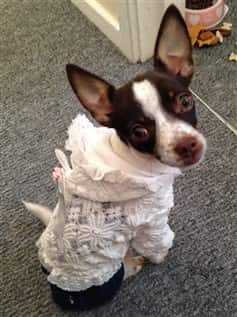Chihuahua Allergies
Overview
About 20% of dogs suffer from some sort of allergy, and this can cause a range of troubling symptoms. In many cases, attempts at treating them fall short; a Chihuahua may only have temporary or partial relief. And this can be frustrating for owners, since allergic reactions are quite hard on this tiny breed.
Fortunately, it is possible to see significant improvement when a Chihuahua has allergies, if you are willing to do the work.
This section will cover everything you need to know about diagnosing and treating allergies. Most of these steps can be done from home. It’s time for your Chihuahua to start feeling better, so let’s dive in.
Please note:
PetChiDog is reader-supported. Some of the product suggestions on this page are affiliate links. As an Amazon Associate we earn from qualifying purchases. This is at no extra cost to you and helps keep this site running.
Already have all the info you need regarding allergies including getting rid of the triggers, and just want to know what you can do to make your Chi feel better right now? If so, jump to: Part 2: Treat Your Chihuahua for Itching and Other Issues Due to Allergies.
Types of Allergies

Rocky, at 1 yr old, photo
courtesy of Brian Ware
Though a Chihuahua can be allergic to just about any element, allergies can be categorized into 3 main groups:
Food:
This refers to anything that a dog ingests via meals and snacks. The most common type of food allergy is to additives in dog food. Other than the very top leading brands, most dog foods contain chemical preservatives, artificial coloring, and/or artificial flavoring. And these chemicals and dyes can cause severe issues.
This also includes low-quality fillers such as high levels of grain, corn, soy, and by-products.
Finally, though much rarer, it is possible for a dog to be allergic to a protein. This may be any base such as fish, beef, or even chicken, which is typically a very well-tolerated meat.
Environmental:
This refers to airborne allergens and elements both inside and outside the home. Seasonal triggers such as pollen, grasses, and weeds are high on the top of this list. This also includes dust mites, which are a leading cause of allergies inside the house.
Symptoms
It’s important to note that a Chihuahua can have just one, some, or all of these symptoms. And reactions can change with time; they can come and go and vary with intensity. Signs include:
- Dry skin
- Irritated skin
- Rash
- Hot spots
- Skin sores
- Atopy (chronic skin disease)
- Itching
- Hair loss
- Reoccurring ear infections
- Upset stomach (most commonly seen with a food allergy)
- Vomiting (most commonly seen with a food allergy)
- Wheezing
- Coughing
- Bloodshot eyes
- Teary eyes
- Behaviors due to itching or discomfort including scratching, licking, and chewing
What to Know About Your Chihuahua’s Allergies Before We Begin
Allergies can be a tricky thing. There’s a good chance that you’ve tried to treat your Chihuahua’s allergies already, and maybe you’ve even brought your Chi to the veterinarian, but there’s been little to no improvement, or only temporary results.
To completely resolve your Chihuahua’s allergies, 3 things need to happen:
1. Significant reduction or complete elimination of all allergen triggers. For example, if a Chihuahua has seasonal pollen allergies, and owners rinse the dog’s paws after coming in, but everyone still wears their shoes in the house… or if the floors are properly vacuumed but windows are left open, allergies will probably continue. If a Chihuahua has food allergies and a better kibble is given, but snacks still contain chemicals, the allergies may continue.
2. Effective treatment to offer immediate relief and resolve issues.
There are some great products that can immediately stop itching and clear up the skin, and even some lotions that can promote fur growth. There’s sprays to heal hot spots, and shampoos to soothe skin irritations. But, you’ll want to use the best anti-itch and allergy products available, and be sure to use them as directed.

3. Ongoing attention to both allergen avoidance and use of quality prevention products.
Once allergies are clearing up, it’s important to continue to keep allergens at bay. And keep in mind that these may change with the seasons; care elements change from winter to summer.
In addition, using the right type of shampoos
and daily care products to keep your Chihuahua’s skin, coat, paws, and nose in good health is important.
And keep these 2 things in mind:
1) Dogs can have more than one type of allergy.
Often, owners or even vets, focus on just one branch of allergies, i.e. environmental. But, a Chihuahua can have food and environmental allergies, or food and contact, or any other combination of the three. All will need to be addressed.
2) Fixing allergies cannot be done with shortcuts.
Treating allergy problems quickly and permanently will mean a commitment to following all applicable steps. If allergies are making your Chihuahua miserable, now is not the time to halfheartedly keep allergens at bay or skip over remedies.
Diagnosing Allergies
It would make sense that the first step in treating your Chihuahua’s allergies is to know what is causing them in the first place. This is a bit easier said than done; let’s look at the choices.
There are two types of testing that veterinarians can run:
Blood tests
– These check for antigen-induced antibodies in a dog's blood. The most common one is ELISA (enzyme-linked immunosorbent assay). This checks for all 3 types of allergies, but is more accurate with airborne triggers (pollen, dust mites, etc.) than it is for food or contact. Though this test can be helpful to a certain degree, it was designed for humans, so it is known to have false positives and results can be inconclusive.
Intradermal skin testing
– This tends to be more accurate than blood testing, however it is not perfect. A dog needs to be sedated for this test and cannot be given any antihistamine or allergy medications beforehand for at least a month, and sometimes longer.
With this, fur is shaved off on a small area and minute amounts of allergens are injected just under the skin; the area will be checked to see which, if any, are causing reactions. This is diagnostic tool is reliable approximately 75% of the time, since the extent of skin reaction is not always clear and different vets will have differing opinions as to what constitutes a true reaction.
Testing at home:

You may wonder if you can test your Chihuahua for allergies at home. In a way, you can. From home, you can take note of elements that seem to cause or worsen symptoms. And, as you work to remove the most common culprits, you can see if there’s improvement.
Veterinary diagnosing Vs. at home diagnosing:
Though the aforementioned allergy testing done through the veterinarian is not guaranteed to pinpoint triggers, it is still a good idea to take your Chihuahua to the veterinarian. If a Chihuahua is having moderate to severe allergies, prescribed medications may be needed including antihistamines and anti-inflammatories.
In addition, there are some conditions that can mimic allergies. A veterinarian will be able to rule out, among other things: mange, mites, bacterial skin infection, fleas (often hidden under the coat and not visible to owners), and diseases including hormonal deficiencies and Cushing’s disease.
Whether blood or skin testing is or is not done, either way there will be a need to make changes to your Chi’s diet, environment, and/or care. And this is what we will dive into next.
Part 1: Remove All Possible Allergens
As we covered above, working to reduce or eliminate all possible triggers is a vital part to fixing allergies for good. And, Chihuahuas can be sensitive to a number of elements. For this reason, we’ll cover how to reduce or remove all 3 types of allergy triggers. Do not automatically discount any of these; but, rather assess each as it may relate to your Chihuahua.
1. Food Allergens
Reactions to an ingredient(s) in food accounts for about 20% of allergies seen with dogs.
The top 3 concerns:
1.
Chemicals. This is a common culprit and includes synthetic preservatives, coloring, and or flavoring.
2.
Filler ingredients. This is also a top trigger and includes grains, corn, and soy.
3.
Proteins. Much rarer, but still possible, is a sensitivity to a certain protein. This can be beef, chicken, turkey, lamb, fish, or even rabbit.
What to do:
Reassess all meals and snacks. Take a close look at both your Chihuahua’s main meals and all treats.
Tip: Steer clear of:
- Grain, corn, soy, wheat, or by-products
- Any ingredients with the added words of hulls, husks, mill run, or gluten.
- Chemical preservatives including BHA (Butylated Hydroxyanisole), BHT (Butylated Hydroxytoluene), PG (Propylene Glycol), TBHQ (Tertiary Butylhydroquinone), Glyceryl Monostearate, and Phosphoric Acid.
- Coloring including Blue 2, Red 40, Yellow 5 and 6, and 4-MIE.
What to look for:
- Zero chemical preservatives, zero artificial coloring
- 100% grain free
- No corn, soy, or by-products
- Food persevered naturally. This can be with a vitamin blend; vitamin C (ascorbic acid) or vitamin E (tocopherols), and/or with rosemary oil.
- Extra ingredients for good health, including antioxidants to boost the immune system and omega 3 to support good skin health.
- Made in the USA.
- Note that rice is usually just fine and very well tolerated, since it does not contain gluten as wheat does.
Recommendations:
Meals:
One of the best kibbles for allergy issues with Chihuahuas is Wellness Complete for Toy Breeds (see below). It meets every single one of the checklist items above for what you want a dog food to have.
If you suspect that your Chihuahua is allergic to chicken (the most common protein used in dog foods since it typically very well tolerated), Wellness Complete makes a Small Breed formula of Whitefish, Salmon, and Peas; the kibble size is slightly larger but is often just fine for adult Chihuahuas.
Alternatively, Merrick, another superior brand, offers 100% grain-free beef, lamb, and salmon recipes.
Note:
If you suspect or know that your Chihuahua has a particular food allergy, it can take up to 12 full weeks for symptoms to entirely disappear after making a switch. So, choose the newer food wisely, and keep your Chi on the new diet for those 12 weeks before making a decision about whether it is working or not.
Snacks: For most Chihuahuas, treats will make up 10 to 30% of the day’s diet, so these must be held to high standards as well. Wellness has a great line of snacks including turkey & duck, lamb & salmon, and chicken & carrots. And Old Mother Hubbard makes a great line of all-natural treats including Bacon & Cheese, Chicken & Apple, and Peanut Butter & Apples.
Look below for the recommendations we just covered.
If you do not see the images, try a refresh. And on mobile, you may need to turn your screen horizontal to see all 4.
And next, we will cover steps to remove allergens with both environmental and contact allergies. Then, we’ll dive into how to help a Chihuahua with itching, skin lesions, and other allergic reactions.
2. Environmental Allergens

Overview:
This is also sometimes referred to as airborne, seasonal, or inhaled allergies, and these may change throughout the year. In the spring and summer, airborne allergens that may be affecting your Chihuahua include pollen, grasses, and weeds.
In the autumn, ragweed can cause reactions. In the winter, dust mites are a common culprit since windows are closed and more time is spent inside.
However, this also includes such things as cleaning products that you may use in your home, that will be applicable all year-round.
What to do:
Cleanse the house of all possible allergens that may be bothering your Chihuahua:
1. If you have a central air system, run the AC or just the fan while using quality filters. HEPA filters are rated with the MERV system (Minimum Efficiency Reporting Value) and with other types of filters you will see an FPR (Filter Performance Rating). The higher the number, the better, since it will catch smaller particles.
When your goal is to properly filter out allergens, you’ll want to replace the filter every 20 to 30 days.
2. If you do not have central air, consider using portable air filtering systems. These standalone devices can be a bit pricy, but well worth the investment if your Chihuahua has bad airborne or seasonal allergies. Be sure that the device is HEPA certified and that it is appropriately sized for the rooms in your home.
3. Routinely vacuum
your entire house with a vacuum cleaner that uses HEPA filtration, no matter which types of floors you have (wood, laminate, tiles, or carpeting). Not only will this pick up all particles on the flooring, but air will be filtered as it cycles through the machine.
4. Do not keep windows open, as this will counteract all the work you did to clean the house of allergens.
5. Have a ‘no shoe’ rule, so that everyone removes their shoes as soon as they enter the house. Keep shoes up high where your Chihuahua cannot reach them.
6. Wet-dust the house
once per week to remove dust mites. Did you know that all dust contains mites? Just 1 gram (about a half of a teaspoon) contains up to 1,000 mites
and 250,000 feces pellets which also cause allergic reactions. Dry-dusting just moves these pests around, but wet-dusting will allow you to trap and dispose of dust, dust mites, and their droppings.
7. Use aerosol cleansers and air fresheners sparingly.
When you need to use chemical cleaning products, it’s best to have your Chihuahua in another room. And the overuse of air freshener sprays can irritate a Chi’s eyes and/or breathing.
Keep allergens off of your Chihuahua:
1. Use grooming wipes, to wipe down your Chihuahua every time that he comes back into the house. This applies to both short bathroom trips and long walks. Use a hypo-allergenic wipe like Earthbath All Natural Hypo-Allergenic Grooming Wipes .
.
2. Use paw wax
to create a barrier between your Chi’s paws and possible allergens on the ground.

Princess, at 1 year old,
photo courtesy of Dani Ruzicka
A good paw wax like Musher's Secret Paw Protection Wax
 will also help heal severely dried, cracked or otherwise damaged paws. This is very applicable to many Chihuahuas since itching is a top sign of allergies. When a dog is very itchy, he’ll chew at any areas that he can easily reach, and this often means the paws.
will also help heal severely dried, cracked or otherwise damaged paws. This is very applicable to many Chihuahuas since itching is a top sign of allergies. When a dog is very itchy, he’ll chew at any areas that he can easily reach, and this often means the paws.
3. Take note of outdoor grassy areas
that may have been sprayed with pest control chemicals and avoid these areas.
4. Rinse the paws after coming back inside
(best if you pick up your Chihuahua and carry him to the sink). While paw wax will repel many elements, you’ll still want to wash the paws of any outdoor reside each time your Chi enters inside.
5. Brush and bathe your Chihuahua on time.
Brush the coat as often as once per day and at least once every 3 days. Normally, baths are given
once every 3 weeks; but, if your Chihuahua requires a specialize allergy shampoo to heal his skin and reduce symptoms, baths can be given as often as 3 times per week until symptoms resolve. We’ll cover more details ahead in Part 2: Treat Your Chihuahua for Itching and Other Issues Due to Allergies.

Gizmo, at 1 year old,
photo courtesy of Dani Ruzicka
3. Contact Allergens
Overview:
Contact allergies refers to something that a Chihuahua is coming into physical contact with. This is the least common type of allergy with dogs, but should not be entirely dismissed.
Plastic bowls are a top concern here, and this often manifests with an overly dry nose and/or loss of nose pigmentation. Owners may assume that fading nose color is due to genetics, but in many cases, it happens due to a reaction to cheap plastics, even those that are BPA free.
This also refers to fabrics such as furniture, carpeting, or even bed linens, and if so, this will most often manifest with skin reactions.
What to do:
1. Do not let your Chi eat or drink from plastic bowls.
Only use stainless steel or ceramic bowls for both food and water. Properly sized, quality bowls like the Kek's Stainless Steel Bowl Set for Small Dogs
 is a great choice.
is a great choice.
2. Assess fabrics in the house.
Sometimes, laundering washables with hypo-allergenic detergent can help, but in some cases, things will need to be replaced with less irritating fabrics or the Chihuahua will need to have restricted access.
If you suspect that wall-to-wall carpeting is part of the issue, encourage your Chi to rest/sleep in his bed and/or place down non-irritating blankets.
Part 2: Treat Your Chihuahua for Itching and Other Issues Due to Allergies
While working to reduce or remove all possible allergens is one part of fixing Chihuahua allergies, the other part, treating symptoms, is just as important.
And do keep in mind that both parts must be done. If you only remove triggers, your Chihuahua can still suffer symptoms for weeks or even months. This is because such things as dry skin or rashes can take a long time to clear up on their own.
Likewise, if you only treat symptoms, but do not work to remove triggers, your Chi may find only limited relief. If a puppy or dog is still being bombarded by allergens, this will be an uphill battle.
Veterinary treatment Vs. At Home:
Most owners do not like to hear that a veterinary visit is necessary. However, not all conditions can be treated at home. Moderate to severe allergies may need to be treated with prescribed antihistamines and/or anti-inflammatory medications.
If your Chihuahua’s skin is severely swollen, cracked, and/or has deep sores or lesions with pus-like discharge, or if your Chi has breathing issues including moderate to severe wheezing, a vet visit is warranted.
This said, there is a lot you can do from home to help your Chihuahua find relief from terribly itchy skin, hot spots, and other common issues. So, let’s take a look at what can help:

Oliver , at 8 months old,
photo courtesy of Suzy and Wesley Linder
1. Sprays
– Topical sprays are very helpful, since these can offer a Chihuahua immediate, targeted relief.
Hot Spot spray:
This will be designed to quickly cool sores, welts, or other severely irritated areas. Because the skin may be broken open, an all-natural spray is often best. Such ingredients as tea tree oil and aloe vera can be very soothing and prompt skin to heal.
Anti-itch spray:
There are two types; medicated and non-medicated.
Medicated sprays
are best for very intense itching and possible swelling of the skin; and you’ll want to look for one with hydrocortisone or a combination of hydrocortisone and lidocaine. Hydrocortisone works to quickly stop itching and will help reduce irritation. Lidocaine is a numbing agent that can help if a Chihuahua's skin is so bad that the dog is sore and uncomfortable.
Organic sprays can be highly effective as well for itching, rashes, irritated skin, and other skin issues. This is a good choice if your Chihuahua is not quite so bad that a medicated spray is required, or should be used for any areas of the body that your Chi may chew at or otherwise be able to ingest the product.
Those containing oatmeal and baking soda typically work very well.
Our recommended topical allergy sprays can be seen below.
This includes:
- Vet’s Best hot spot spray that contains tea tree oil, aloe vera, and chamomile.
- Dr. Gold's Relief, which is one of the very best medicated sprays available; this contains both hydrocortisone and lidocaine for super-fast, soothing relief from itching and discomfort.
- Pet King's zymox spray, which is a fantastic option if you’re looking for one with just hydrocortisone.
- Bodhi Dog, which is great for itching, with its non-toxic yet effective blend of oatmeal and baking soda.
If you do not see the images, try a refresh. And on mobile, you may need to turn your screen horizontal to see all 4.
And next,
we’ll cover lotions, which can provide full-body relief, and shampoos which are a vital part of treating skin reactions.
2. Lotions
– If your Chihuahua’s entire body is raw, itchy, or otherwise in need of help due to allergies, you may find that a lotion is a better choice than a targeted spray. This can be massaged onto large areas of irritation and can be ultra-soothing and restorative.
The top one that we recommend, ReQ (see below, under ‘omega fish oils’) works on many levels and for many issues. It helps cure excessive dryness (body, paws, and/or the nose), hot spots, severe itching, and even helps restore thinning coat.
It contains a comforting blend of aloe vera, Manuka honey, coconut, hemp seed oil, olive oil, and shea butter – all of which help with itch, moisturize and repair, and vitamins A (to boost collagen), B (to moisturize, protect the skin’s immune cells, and strengthen the skin’s outer layer), C (to boost collagen and moisturize), and E (a potent antioxidant).

3. Allergy Shampoo
– Shampoo is a very helpful tool to resolve allergic skin reactions. You'll want to choose a really good one, lather up your Chihuahua’s entire body, and leave the product on for a good 10 minutes, allowing it to soak in for ultimate relief and restoration.
Normally, a Chihuahua should have a bath once every 3 weeks; but, when there’s allergy issues, you can use a quality shampoo as often as every 3 days.
As long as you’re also working to reduce triggers, you should see improvement within 2 weeks, and then you can shampoo your Chi once to twice per week until issues are fully resolved.
1.
There are several good allergy shampoos for dogs; however, our top recommended one has to be Moosh (see below); it’s really hard to beat. It works exceedingly well for itching, hot spots, and severe dry skin. It also works on flaking, peeling, dandruff, and even yeast or fungal infections.
Moosh contains bentonite clay, argan oil, neem oil, shea butter, aloe vera, vetiver oil, coconut oil, sunflower oil, and olive oil.
2.
Earthbath is a close match, and this is because it’s a top-quality line of shampoos that target specific issues that a dog may be having.
Their Oatmeal and Aloe formula is great for allergies (and is actually the shampoo we recommend for continued care since Chihuahuas have sensitive skin). They also have a Eucalyptus and Peppermint shampoo that is super-cooling for dogs that have sore, irritated skin. Their Tea Tree and Aloe Vera formula is fantastic for purely itching issues or hot spots.
And their one conditioner, Oatmeal and Aloe, is very complementary to any of their shampoos.
4. Omega 3 fish oil
– An omega supplement alone will rarely fix severe skin issues or fully cure itching due to allergies. However, when you are working to treat your Chihuahua, this can be an added bonus. Fish oil is well-known for its ability to heal skin. If your Chi has had coat issues as well, it can help fur grow back strong and healthy.
Be choosy about which supplement you offer to your Chihuahua. Omega made from flaxseed is entirely different than that which is derived from fish, and will not work nearly as good. Also, the fish should be wild, not farmed, since farmed fish can contain up to 15% vegetable oil which lowers the actual omega 3 levels.
You’ll find that a liquid fish oil is a good choice, making it easy to add to your Chi’s food (add to 1 meal per day). Chihuahuas only need about 1/2 pump, and be sure to mix this very well into the kibble. Most dogs love the smell and the taste, so if it’s not blended good, a dog will mouth just the pieces that are coated with the oil.
One of the best is a fish oil made by Zesty Paws (see below). It is 100% pure wild Alaskan Salmon, and is made in the USA. It’s also very budget friendly, offering almost double the amount (32 oz.) than other brands.
Our recommended allergy lotion, shampoos, and omega 3 fish oil are below.
If you do not see the images, try a refresh. And on mobile, you may need to turn your screen horizontal to see all 4.
And next, we’ll the cover medications, then go over important ongoing care to prevent re-occurrence.
Medications
- There are medications that can help with allergies, both over-the-counter and prescribed. There are side effects for all of these, and all need to be given with great care and accuracy.
OTC, Benadryl:
For minor and acute symptoms, you can give Benadryl to your Chihuahua, under veterinary guidance.
You'll want to be careful with this, since 1)
it is not meant for long-term use, 2)
this only helps with some symptoms but does not cure any allergies; the best way to resolve allergies for good is to work to remove triggers, 3)
it may help with itching, bloodshot eyes, and wheezing to some degree but will not heal up moderate to severe skin issues, 4)
this causes drowsiness, and 5)
you have to be very careful with dosing since the Chihuahua is such a tiny breed and just a bit too much can cause an overdose.
This all said, dosing is 1 mg for each 1 pound of body weight; but please check with your veterinarian before giving this.
Prescribed medications:
As we touched on earlier, for moderate to severe allergies, the veterinarian can prescribe certain medications. This includes an immunosuppressant like Cyclosporine (Atopica), antihistimines including Hydroxyzine HCl, and oral or topical steroids like Prednisone.
Immune-modulating allergy shots is another option, but we do not recommend this. This involves injecting a dog with certain allergens to build up a tolerance. This is very expensive, there is little research to prove that this works well, and there is serious risk including anaphylaxis shock.
Part 3: Ongoing Attention and Care

Prince, at 1 year old,
photo courtesy of Dani Ruzicka
Now that you’ve worked hard to remove or at least reduce all possible allergy triggers, and you have used some of the best products to treat your Chi’s skin, you won’t want to drop the ball. While some dogs can outgrow allergies, many do not. So, you’ll want to stay on guard.
Here’s 3 top tips for keeping your Chihuahua allergy free:
1. Once you’ve found a good kibble and some great snacks, don’t veer off course. Do not allow anyone to feed your Chihuahua something other than these. Keep your supplies well-stocked so that you don’t run out.
Sometimes, superior food and healthy treats
are not readily available in local pet stores or in your supermarket (they often stack rows of cheap, chemical-laden ones). So, if your ordering online, keep shipping times in mind.
2. Once you’ve cleared the house of allergens, keep up with this. Most owners find it helpful to keep a strict schedule; vacuuming every Saturday, checking air filters on the first day of the month, etc.
3. Keep a regular grooming routine for your Chihuahua.
If you can keep your Chihuahua’s skin healthy and strong, your puppy or dog will better be able to handle any sort of new allergy attack.
Let’s look at what should be done regularly:
- Paw wax: Good to use year-round, but especially helpful in the winter and summertime. Massage onto and between paw pads 1 time per week. Apply once per day to fix paw issues.
- Nose balm: Noses are a vulnerable body part for dogs and should be kept in good shape. A good balm like Snout Soother
can prevent drying and chapping. Apply once per week for maintenance, and up to 3 times per day to fix nose issues.
- Good shampoos and conditioners: Don’t wait until there’s problems to start using a moisturizing shampoo. When you give your Chi a bath every 3 weeks, the aforementioned Earthbath will keep a Chi’s skin and coat super healthy, and nip new skin allergy reactions in the bud.
- Coat sprays: Another good tool in your arsenal to keep a Chi’s skin and coat healthy. A leave-in spritz will help protect against outdoor elements, contract friction, and repel debris. An added bonus is that one like Nootie Daily Spritz - Warm Vanilla Cookie
can keep your Chi smelling super nice. Spritz the coat every 3 to 4 days.
- Use grooming wipes in between baths, as often as every day.
- Brush the coat at least every 3 days.
Did you find this article to be helpful?
If so, you'll love The GIANT Book of Chihuahua Care.
You May Also Like:
Chihuahua Puppy Vaccinations
- Which shots are needed and a schedule of when each inoculation is given.
Home Cooking for a Chihuahua
- Do you want to try cooking for your Chi? It's a good way to be in complete control of what your Chi eats.
Common Chihuahua Eating Problems
- If you're having some struggles at meal time, there's a good chance that one of these top issues is at play.
